-
Posts
91 -
Joined
-
Last visited
Content Type
Profiles
Forums
Store
Help Articles
Posts posted by Cheeko
-
-
Kakinomoto (edible kiku flowers) (Sorry I can't spell the English word for kiku
 . Can you?)
. Can you?)...chrysanthemum -- but if you wanted to sound "posh" then you'd just say "mums"
 My dad grew the yellow ones in our garden but I don't remember eating the flowers - just the green part of the plant.
My dad grew the yellow ones in our garden but I don't remember eating the flowers - just the green part of the plant. -
Or, could you pan-fry a chicken breast?
...or Cornish Game Hen...or you can just stew or simmer a turkey/chicken. Think of it this way, if you stew it, you've saved yourself the arduous task of making soup.
How about a steamed kabocha cake - very easy (1/2 kabocha, 2 eggs, sugar to taste, steam 15 minutes) and you can add the pumpkin spice as you like. You can slice the cake and serve on a cookie?
You can also make a lot of foods we consider "baked" by checking out the tricks of the chuck wagon cookers? --- [edit] Sorry, I realized later that you'll need a dutch oven for that and a heat source to put on the top. How about something like bannock?
-
I have also sometimes seen a curry flavored fried rice/pilaf style rice called dry curry.
That's how my mom always makes her version of fried rice. Until she was able to find S&B curry powder, she used the American curry powders (such as Durkee) which added a weird green tint to the dish. Still very, very delicious

-
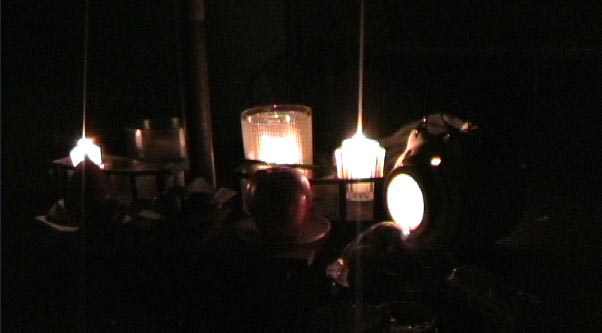
Had to rely on my video camera to get the nightime shots of our moon-viewing dinner. Maybe time upgrade the digital cam!
I should mention that my parents didn’t celebrate tsukimi – it didn't come onto my scope until my oldest brother was married. Her family was from China so when she entered into our family, the moon viewing festivities really began for our side of the family. I generally associate this celebration with massive quantities of food, the gift of big oranges, moon cakes, white rabbit candies and big family banquets. Trying to achieve this with just a husband and two cats is a little hard, but I wanted to hang on to the Chinese tradition of seeing the moon as a symbol of “reunion.”
My moon cakes arrived right before we headed out the door. The bakery had apparently run out of the traditional adzuki bean and egg yolk cakes so they sent us individual cakes with white lotus seed and winter melon. I was actually quite happy about this little unexpected change in fortune!

Moon cakes to the bottom right corner: White lotus seed and wintermelon
Earlier that day I had prepared my version of “tsukimi dango” – basically small, spherical shaped daifuku filled with anko and ground sesame seeds. It was more savory than sweet. Instead of using a regular mochi skin, I used a yatsuhashi recipe that gave me the bite of a fancy mochi without the fuss.

Since I don’t have access to a lot of the traditional items, I decided I would try to honor the spirit of tsukimi and decorate our table with seasonal fruits and special items I ordered for the celebration.

Next, I rolled out the udon dough that I had prepared the day before. The idea was to save some time and roll it flat, then cut into noodles and cook when we returned from work. Unfortunately, it didn’t work as well as I hoped. The noodles were okay, but the dough had rested too long and the gluten had taken a holiday. Not chewy enough for me.

A soft-boiled egg substitutes for a raw egg in this version of tsukimi udon. I added sliced white kamaboko (trying to keep in the spirit of the moon?)
My husband was initially a little hesitant to sit outside and eat hot noodles – sundown had happened only 15 minutes earlier and it was still rather warm outside. But he was kind enough to humor me plus he knew he’d have to eat alone if he didn’t join me. Eventually it cooled down outside and we enjoyed the meal as the moon started to rise.
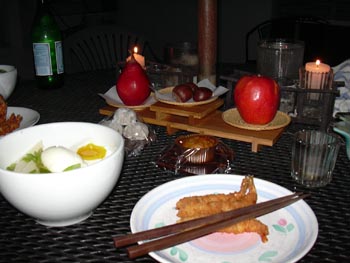
We debated on whether there was a rabbit pounding rice cakes or a princess on the moon. I like the idea of a rabbit although the swirling princess works better with the amorphous cratering of the moon. There were no innocents to steal rice cakes from the table, (just a hungry looking katori buta) so I went ahead and bit into the white lotus seed moon cake. It was delicious.

Princess or mochi-pounding rabbit? Actually, never could get a really good shot of the moon - this one came from the video camera as well.

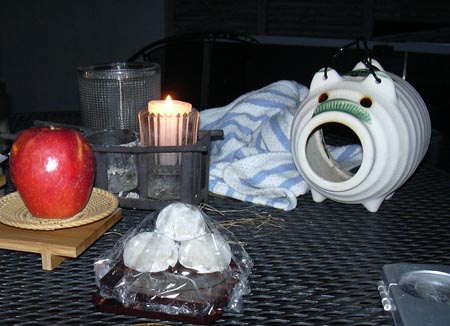
Hungry Buta eyes the tiny stack of dango
-
Gorgeous day in Florida, should be cool, dry and clear for tonight's harvest moon. Prepared some dango and udon. I am crossing my fingers that my moon cakes will arrive today (in honor of my brother's wife's influences on my celebrations tonight). I thought about trying to make them myself, but decided that was a little too ambitious and I don't have a mold. My chestnut plans were foiled by FedEx. They are quite fond of sending my packages back to the distribution station an hour away from me after being just minutes from my house.
Menu following work tonight will be "tsukimi udon" -- not really traditional for moon viewing plus I won't do the raw egg - my husband won't eat it
 Will post pictures later tonight.
Will post pictures later tonight. -
Even though I "feel" Japanese (whatever that means, I know), I feel that these are major impediments to breaking through that wall and getting into that inner circle where maybe I will "feel" more Japanese and be perceived as maybe at least 50% Japanese! It sounds silly, but I think that there may be some people out there who can identify.
Yes, I can certainly identify with your current situation, but I know it was my parent’s strong desire to raise us all to be who we were wherever we might find ourselves. It was a nice idea, but it was not realistic because you just can’t deprogram that part of your genetics. As one writer once said, we (the children) are the sum of us, -- meaning my parent’s life experiences and their parents, and so on and so on. Regardless of what boundaries you see, forget the inner circle and just enjoy this journey you are taking. You’ll get there. Food is such a great way to recover, restore and heal the past and best of all, it doesn’t judge you. I also happen to believe that people who genuinely love food need to share it – isn’t that why were all here?

JasonZ:
A hearty vote for that idea… but that’s easy for me to say, sitting here safely ensconced in my armchair. I loved going through the various pictures people posted of various “ebiken” in the regional topics. They made me daydream; What a great way to show regional specialties and what a great excuse to write a book – travel throughout Japan on the train, catalogue the various ebiken then get off the train and check out the regional foods – all on the publisher’s tab! ….sigh… just dreaming….

-
I mulled over this question for a reply and now I'll mull over your clarifications

For me, really learning (and relearning) about Japanese food is about retracing my past and my parents past. There is a bond with food and memories -- more so when you talk about the food of cultures and regions that are used to growing and harvesting their own food, rather than going to the market and buying it.
I think any culture/region that is connected to the food it grows and harvests is worth learning, especially in this day and age when we have grown more and more disjunct from the spirit of the "fruit of the sea and of the mountains."
The more I learn about Japanese food I also learn there are many cross-cultural similarities interms of the approach to cooking/seasoning. The closer you get to the coastal communities, the more you see people preferring fish as fish -- not covered in a basil-chili-mango pesto or something else overpowering. They want it simple and clean. The further south you move down the east coast, the more rice you see in the regional cooking.
I think misunderstood might be too strong of a word... I would probably think more interms of disconnected in general with food... ?
-
The quote above mentions that the live bacteria are what give it its special characteristics. This brand has L. bulgaricus 2038, S. thermophilus 1131 and LB 81. Anyone have any American yogurt around to compare??
 This is from my favorite "organic", low-fat yogurt call Brown Cow.
This is from my favorite "organic", low-fat yogurt call Brown Cow.Active Cultures: S. Thermophilus, I Bulgaricus, I Acidophilus and Bifidus. No "numbers" following the culture names.
Other additives: pectin and tapioca starch
I'm afraid that if you want to make your own yogurt close to what you're enjoying now, you will need to have your own cow in your backyard
 This yogurt is made is pasteurized milk. If you've ever watched the BBC comedy "Chef" there is a hysterical episode about Gareth running around all over England trying to find an unscrupulous dairy farmer that will make him Stilton Cheese from unpasteurized cream.
This yogurt is made is pasteurized milk. If you've ever watched the BBC comedy "Chef" there is a hysterical episode about Gareth running around all over England trying to find an unscrupulous dairy farmer that will make him Stilton Cheese from unpasteurized cream.If you are serious about making your own yogurt, there are places in the US that sell "raw" milk.
-
Nice thread this one
I have bought at the local Japanese grocer a kind of sweet bean bar wrapped in plastic packaging. I wonder what category it would fit in since no bean skins at all and I like it very much. Back in the old country we have plenty of similar products though not made with beans.
BTW are there any recipes with azukii beans?
thanks
Is it jelly-like? It sounds like you might have yokan - its made with adzuki bean jam and kanten, a gelatin that comes from sea weed.
There are a lot of sweets both in Japanese and Chinese cooking that use these versatile beans; are you looking for a recipe for this yokan? Or any sweets using these versatile beans? "tsukimi" is coming up next week (moon viewing celebrations) so you might be able to find quite a few examples of adzuki sweets such as the Chinese mooncake (pastry wrapped around bean jam and chestnut or preserved egg yolk) or the Japanese tsukimi dango (rice cake sometimes wrapped with bean paste and toasted soybean flour). Both are quite delicious

-
I know what you mean about mushy rice - and I feel that rice is generally cooked softer these days than when I first came to Japan.
I'm surprised to hear that -- I just thought it was something that a lot of restaurants did here to "suit the American palate."
I sent some of this morning's onigiri (via my husband) to a coworker who was appreciative, but unwittingly placed them in the refridgerator. When he told me about this, I groaned. Hubby didn't know that that was a bad thing to do with such well-bred onigiris. I hope they survived the few hours and I hope she didn't put them in the microwave...
-
Cheeko:
I'm glad that you seemed to like it despite its exorbitant price. As local people here often say, you can tell good rice when it cools. But "al dente"?
 It may have been due to less water than necessary.
It may have been due to less water than necessary.You are such a great onigiri maker! I can't make such beautifully shaped, triangular onigiri. My wife is as good as you are, though.
Now I'm interested to hear what your husband has to say about the onigiri, expecially its price.

I use the word "al dente" in this case to describe rice that isn't mushy -- I don't mean to say it had actual chewiness like udon. For instance, a lot of sushi places that I have gone to here make rice that is, in my opinion, too soft and mushy. I could use it as glue for paper crafts right there at the table - I haven't, but you get the idea.
I can't take credit for the shape -- I used a mold

My husband doesn't have to worry about price - my experiment so it comes out of my pocketbook. However, his reaction was more typical of new rice-converts. He really didn't notice a difference until I cooked regular rice for dinner. He immediately noticed the difference...and proceeded on with dinner, leaving more than half a bowl of uneaten rice. He said he was really full
 Have I created a monster?
Have I created a monster? -
...and now I am a believer
Woke up on the early side and decided that I'd make "salty-rice" (that's what we called the shio onigiri when I was little) for my husband's lunch.
I cooked as per the machine's instructions instead of the packager's instructions. It might have been a gamble, but I've had great luck with the machine: not so much with the Williams-Sonoma food products. I should mention that Williams Sonoma is the exclusive retail seller of this rice. You can only get it by either calling them or going into a local retailer because it is not available through catalogue or internet.
My initial reaction when I first opened the rice cooker is that it is very "pretty" rice. The WS sales pitch is quite true: "...treasured for its luster, opalescence..." My camera can't quite catch the iridescent colors but they were there.
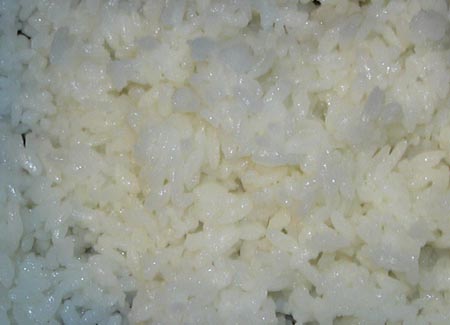
As I stirred the rice, I felt that it was quite light - less dense than the usual rice I cooked. Since it is a short-grain, it was stickier, but as I took the first bite, it wasn't gooey or gummy and it had the "al dente" bite. I will confess that at first bite, I thought ...it's okay, but I don't think its worth 8 bucks a pound!
 but then again, the rice was still very hot. I went ahead and started to make onigiri.
but then again, the rice was still very hot. I went ahead and started to make onigiri.I waitied a few hours before eating one of the onigiri - glad I did. While I can't say I could tell a difference in taste, the mouthfeel was really, really, really good (I'm trying to avoid using the word 'heavenly'
 ) and the onigiri itself was so light. Onigiri made with my everyday Nishiki are "betont", lead-balloons, boat anchors by comparison.
) and the onigiri itself was so light. Onigiri made with my everyday Nishiki are "betont", lead-balloons, boat anchors by comparison.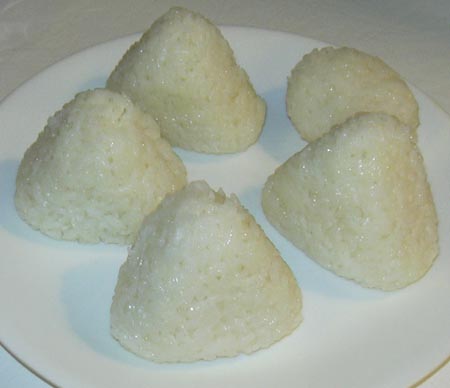
I'm at a disadvantage because of the unavailability of many of the recommended California brands and Japanese imports in my area. I can mail-order them, but the shipping costs will kill me. I would buy this rice again for special occasions but I would reserve it for guests who really like rice by itself - not as a side dish and not as a part of maki sushi.
-
I will be in Japan in December, perhaps in Niigata. I want to bring home (to California) 10kg of rice for my wife. It seems like there are many varieties of koshihikari. What's good and what's not so good? Is there something specific I should target or just get Niigata koshihikari and that should be good enough?Rice harvesting continues this week and it will probably end next week.
Check out the thread on Types of Japanese Rice - I didn't find it until yesterday, but it has a lot of great information on rice in general as well as Koshi-Hikari rice.
Hiroyuki-thanks for posting those pictures of the monument and especially of the rice crop that looks like its almost ready...
-
And, what are you going to do with it??
 I would eat it with some pickle or something and then make onigiri with salt only. I think that's the best way to appreciate the flavor of Koshihikari.
I would eat it with some pickle or something and then make onigiri with salt only. I think that's the best way to appreciate the flavor of Koshihikari. Don't worry. I decided not to make it for dinner because I wanted to enjoy it as simply as possible. Shio onigiri sounds like a good idea.
Don't worry. I decided not to make it for dinner because I wanted to enjoy it as simply as possible. Shio onigiri sounds like a good idea. -
I have the same experience so I'll stick with the kokuho rose.
Although I do feel that there is a difference between the koda label and the nomura label versions. I prefer the koda organic variety but cannot find anything but the nomura pink label now.

Me too...
My parents are big fans of the Kokuho "True Koda Varietal" and YES, YES, YES there is a big difference between the Nomura Pink label. Parents didn't mind that variety either, but then again, as post WWII teens, they learned not to be picky about food in general. I know I said it somewhere else, but to them Spam donburi is a good thing
 . River Rice (an American medium grain variety that is used in more southern dishes like jambalayas and etoufees) is the rice I grew up on and it wasn't until I was in high school that my mom started to get really picky. When I made it to college, that's when her local asian grocer started to carry the Koda Farms varietal on a very limited basis. It was very popular and the grocer had to limit each customer to 11, 20lb bags. Its hard to imagine, but this was a hardship for some folks
. River Rice (an American medium grain variety that is used in more southern dishes like jambalayas and etoufees) is the rice I grew up on and it wasn't until I was in high school that my mom started to get really picky. When I made it to college, that's when her local asian grocer started to carry the Koda Farms varietal on a very limited basis. It was very popular and the grocer had to limit each customer to 11, 20lb bags. Its hard to imagine, but this was a hardship for some folks 
Thanks SuzySushi for mentioning the Kumai Harvest rice. I was a bit turned-off by the marketing pitch, but nonetheless, I had to find me some and find out just how ignorant I am about good rice
 I'll be trying it out tonight and cross your fingers that I don't mess it up.
I'll be trying it out tonight and cross your fingers that I don't mess it up.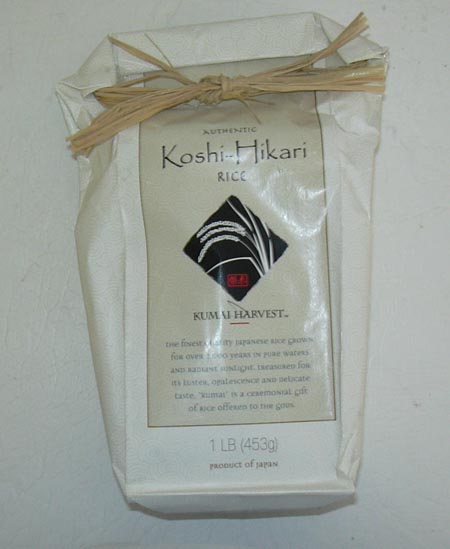
Alas, the packaging tells me little about where this product comes from - just that it is a product of Japan, fancy culinary people like it and that they spent a lot of money on its packaging.
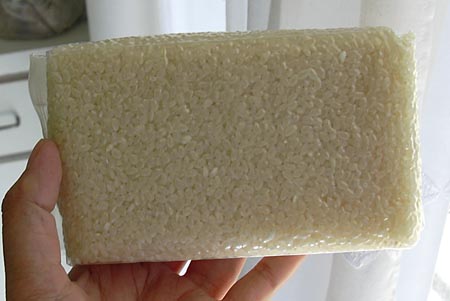
No indication of "shin mai", "ko mai" -- just that it is expensive. I spent the same amount for 3 pounds that I would normally spend on a 20 pound bag. But if its good, then, as Hiroyuki says, its like a fine wine that needs to be enjoyed as a special treat. Nishiki is fine for every day eating.
-
A square watermelon!

I was having an internal struggle about whether I should take a picture in the middle of a high-end shop, but finally I whipped out the camera, snapped the picture, and bolted. (The things I do for the Japan forum!
 ) I bolted so quickly that I didn't catch the price! But, seeing that it was a Sembikiya melon (see above post), I am sure that it was very expensive. Anyone lucky enough to have ever tried one of these? I wonder if it tastes as interesting as it looks. And I really wonder what kind of rational being would buy one of these and how many a day Sembikiya is really able to sell.
) I bolted so quickly that I didn't catch the price! But, seeing that it was a Sembikiya melon (see above post), I am sure that it was very expensive. Anyone lucky enough to have ever tried one of these? I wonder if it tastes as interesting as it looks. And I really wonder what kind of rational being would buy one of these and how many a day Sembikiya is really able to sell.Your guerrilla-photo tatics are greatly appreciated because that melon is simply extraordinary...
Maybe someone thought it would be a good idea to create a square melon so it wouldn't roll when you cut it? Safety first???
Easier to wrap? Just shove it in a nice gift box?

-
Here's a video/recipe for some manju... not sure if I'm up for this project yet

The recipe you provided a link to calls for tsukune imo. I didn't know anything about it, so I googled to find that it's a type of yamaimo (yam?) and it's expensive!
--that's too bad; I just judged from the videos and thought the grated pulp was nagaimo, which I can get a hold of in the US. I could try to use nagaimo instead, but then again, I could be asking for trouble
 Think I'll just stick to little rice cakes
Think I'll just stick to little rice cakes -
Definitely the sweet version - I guess that is the Kansai version? Every now and then I will make scrambled eggs with some soy sauce and a little dash of sugar. I should look for the "Kyou mo tamago yaki" you mentioned in the egg topic
 and I could also try it without sugar.
and I could also try it without sugar. -
Don't I am not celebrating either, actually never have.....
and just talking to my husband now, apparently he doesn't ever remember celebrating either.....
I guess we could always start now!

For 2006, October 6th? Is that right?
Probably a celebration that gives me a good excuse to make more takikomi gohan, wagashi and have a good laugh out on the patio with my husband over our improvised, work-related haikus.
Here's a video/recipe for some manju... not sure if I'm up for this project yet

-
That is just beautiful. What is the pink flowery looking item with the egg?
I think I need friends like your's.
"Kirei desu ne?"

It looks like a little wagashi cake - rice cake filled with bean jam?
I normally associate bentos (in our case, an old nori box) with travelling in the car during the summer. To this day, my sister and I get so excited when we make long road trips because it means we will be making "car food" which consists of rolled egg omlettes, onigiri and some cold chicken. Neither of our husbands understand the enthusiasm. They're just as happy to stop at a Burger King.
Someone posted this link in the Food/Media section of eGullet - bentoTV; a kind of FoodNetwork show for those who love all things bento. It's linked to her eBay store front if you really get inspired

-
... it was
 because I don't think they were real matsutakes. Either that or they just too old and dried out. I shouldn't expect so much from a dried soup mix anyway
because I don't think they were real matsutakes. Either that or they just too old and dried out. I shouldn't expect so much from a dried soup mix anyway 
My favorite rice companion? Nori and sesame seed furikake. If I'm being really bad, ochazuke with lots of arare

-
I also think it must cost more to buy these items here than it would in Japan, but I'm not likely to be able to afford a trip to Japan for another year at least, and I'm too impatient!

Have you checked in your area for pottery artists/craftsmen who might specialize in these types of dishes? It's almost inevitable to find artists who are either trained and or inspired by things like Bizen pottery. There's even this guy in Great Barrington, Massachusetts who went as far as opening a Kaiseki and Restaurant thanks to his pottery training in Bizen. I'll be honest, I ate there once, and I wasn't as inpressed as the reviewers or the staff, but the dishes were quite nice

-
and it was my yellow/black addition to our 5 colored dinner.
5 colored diner... I know what it means, but does the Washoku book explain that principle? I must admit I've never thought of following that principle.

What is that in the big bowl on the left in your second photo?
How often do you make Japanese-style meals?
It doesn't go into too much detail on the principal, but enough for me to understand the simple, nutrional logic that comes with thinking about colors in a meal.
From Elizabeth Andoh's WashokuFive colors, or go shiki, suggest that every meal include foods that are red, yellow, green, black, and white. (Often very dark colors, particularly deep purple - eggplants, grapes - and sometimes brown - shiitake mushrooms - are counted as black.) Vitamins and minerals naturally come into balance with a colorful range of foods.
The book goes on the explain the five tastes (go mi,) the five ways (go ho,) the five senses (go kan,) and the five outlooks (go kan mon.)
Recently, I've started to make Japanese-style meals for dinner. While I don't have the time to always follow the five principals, it does make me think more about what I am planning for dinner and how it will all fall together. Its fine to think about a food pyramid and calories to fat or what will go with a red meat, but I feel like I'm not really "participating" - I feel like I'm just following a routine rather than using a little imagination. I also find that the principals can be applied to western-style meals and without even intending to, I'll discover a "government approved" balanced meal...
The left, big bowl: While mom thinks I'm going through a phase, she is nonetheless interested in what I am learning. She sent us a little care package of food items my aunt sent to her from Kyoto, and one of those was a kind of instant miso soup base with matsutake mushrooms. She didn't like it, neither did we...

-
Do you make joubi sai regularly?
What are your favorites?
One more question: Do you practice ichijuu sansai?
Since reading Elizabeth Andoh's "Washoku" book, I've been trying to prepare joubi sai. Still need some practice
 I made some simmered acorn squash (kabocha's hadn't showed up yet) and it was my yellow/black addition to our 5 colored dinner.
I made some simmered acorn squash (kabocha's hadn't showed up yet) and it was my yellow/black addition to our 5 colored dinner.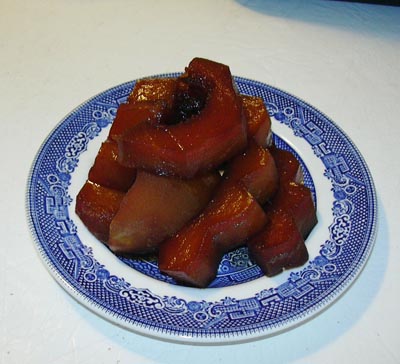
I don't always serve soup but I do try to have the 5 dishes, 5 colors of food present (black, red, white, yellow and green) and vary the cooking methods.
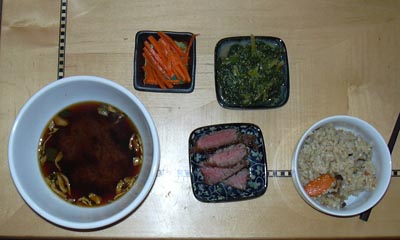 An example would be niku jagu. I want to try this dish and figure a simple cucumber salad would work with it but what else would I serve?
An example would be niku jagu. I want to try this dish and figure a simple cucumber salad would work with it but what else would I serve?Have you seen the Andoh book? It might give you some ideas, especially if you already know some of the things you want to prepare. I like the book very much, and it opened my eyes to how 2 dimensionally I think about cooking and preparing a meal. I've always focused on what ingredients complimented others; never took into consideration how a dish was prepared and how that could compliment another dish. I try (but don't always have time for) a steamed, simmered and fried combination. For instance, you mentioned a slightly sweet simmered dish; it could be complimented by a vegetable that has been fried or broiled. I've eaten it with a small serving of kimchee to contrast sweetness of the nimono stock and a small bit of rice. However, my husband thinks rice with potatoes is overkill
 He's an Atkins/South Beach refugee.
He's an Atkins/South Beach refugee.



Iron Chef America (Part 2)
in Food Media & Arts
Posted
I caught this battle on repeat - lucky, as I haven't followed the series as much as the original. Probably will start to pay closer attention. I get the feeling that Morimoto tends to cook more or less "traditionally" on this series than he does on the Japanese series? Watching him make the classic mushroom takikome gohan in donabe sent me into orbit (or at least onto eGullet to find helpful hints on cooking in a donabe) -- such a simple dish but so delicious. Best part about it is the burnt rice on the sides of the clay pot!!